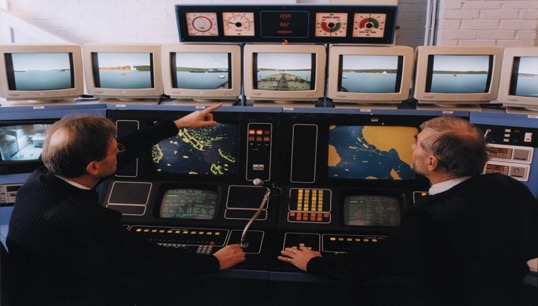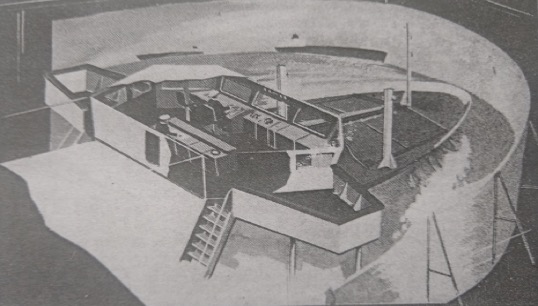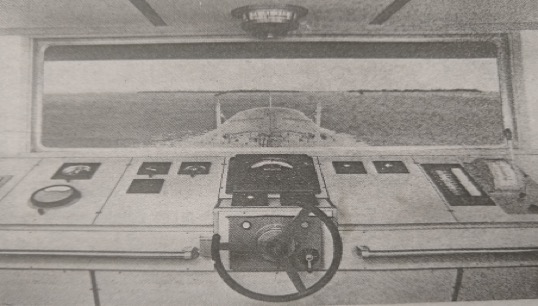- Topics
- Campaigning
- Careers
- Colleges
- Community
- Education and training
- Environment
- Equality
- Federation
- General secretary message
- Government
- Health and safety
- History
- Industrial
- International
- Law
- Members at work
- Nautilus news
- Nautilus partnerships
- Netherlands
- Open days
- Opinion
- Organising
- Podcasts from Nautilus
- Sponsored content
- Switzerland
- Technology
- Ukraine
- United Kingdom
- Welfare

In less than a lifetime, simulator training has moved from the use of wooden blocks on classroom desks to full-mission systems replicating a wide range of shipboard situations. As the debate about simulator use in maritime training continues, Andrew Linington looks back at how the technology has been developed, debated and put to use
Relying on projected dots of red, green and white 'spot' lights to represent oncoming vessels and buoys, it couldn’t do daylight scenes and could only replicate a maximum of two ships – but the simulator at Warsash School of Maritime Studies was Britain's first bridge simulator, and it quickly proved to be a huge success.
Indeed, only a year after it opened in early 1977, Labour MP Stanley Clinton Davies – later to be a trustee of the Merchant Navy & Airline Officers' Association (MNAOA) – told the House of Commons that he had been lucky to see this first simulator in action, saying that it provided an 'invaluable service' to safety at sea.
'I found the simulator a most remarkable piece of enterprise,' he told fellow MPs. 'I am in no doubt that the masters who have the most tremendous experience at sea are able, as I learned at first hand from one of them, to reinforce that knowledge and expertise.'
Origins of the UK simulator
The system was ordered by the Department of Industry following several years of government-sponsored research into the potential for simulators to improve safety at sea.
Simulator techniques had been pioneered at the end of the 1950s, when a programme was developed to train officers in the safe use of radar. This formed part of a drive to cut the number of 'radar-assisted collisions' and the courses – seeking to improve standards of radar observation and interpretation, plotting skills and blind navigation without outside vision – had been supported by Nautilus predecessor union the MNAOA. In 1970, following consultations with the union, the UK introduced a requirement that all candidates for a master's certificate should possess a radar simulator certificate.
Meanwhile, the first use of computer-based seafarer training had been claimed by the United States, using a system developed during the introduction of the world's first nuclear-powered merchant ship, Savannah, in 1959.
Sweden, the Netherlands, the US and Japan had introduced the first shiphandling simulators in the late 1960s. Early on, they were used primarily for research into areas like ship and port design, procedures, and crew behaviour rather than for training.
Not wanting to get left behind, the UK Department for Trade & Industry (DTI) commissioned a series of studies into the benefits of having British simulator facilities. It worked with the Vickers Shipbuilding Group and the British Shipbuilding Federation early in the 1970s to produce proposals for a £1m ship manoeuvring simulator. This drew from the success of one that had been established in 1968 at the TNO institute at Delft, in the Netherlands, which used computer-controlled cameras to project ships, navigational marks and coastlines to give a 120-degree arc of visibility from the bridge.
A report on the potential value of such a system, published by Vickers, stressed the opportunities it could offer for research into improved wheelhouse designs and navigation equipment, as well as investigations into 'human reaction times and behaviour in various circumstances'. It was also suggested the equipment could be used to train up to 400 officers a year, on a four-day course to provide ship handling experience before taking up appointments on new vessels.
In 1974, the DTI commissioned Decca to produce a system for use in training masters and senior deck officers in handling various types of ships – with initial courses for VLCCs, containerships and bulk carriers. Warsash also worked with British Maritime Technology to develop the prototype, and the course content was overseen by a Merchant Navy Training Board (MNTB) management committee whose members included the MNAOA and the Mercantile Marine Service Association.
Former Warsash tutor Professor Mike Barnett describes the system as 'quite primitive compared to today's technology' and says the night-scene-only technology limited training primarily to navigation and collision avoidance.
However, demand proved strong and the courses were rapidly fully booked. The equipment was also used to develop the first bridge team management training following a number of VLCC accidents, and in 1978, a Department of Trade (DoT) inquiry into tanker safety backed the MNTB's calls for the introduction of more simulators for deck officer training to improve standards of passage planning and navigational procedures. Ministers agreed to order three more – a second for Warsash, one for Glasgow and one for South Shields.


Computer-generated imagery
The UK government had also part-funded the development of what was claimed to be the world's first ship simulator to incorporate full computer-generated simulation of 'dusk-night-day' visual scenes. Sited at the University of Wales Institute for Science and Technology (UWIST) in Cardiff, this was hailed as a step-change in training technology when it was opened by the Prince of Wales in 1982. Developed by Marconi Radar Systems, it featured a radically new system for presenting computer-generated imagery (CGI) – Tepigen – which dramatically increased the realism and interactivity of the training scenarios.
Explaining the decision to support the development programme, the government noted that 85% of accidents at sea were the result of human error and the new facility had the ambitious aim of cutting that figure.
Maritime simulator CGI took a major leap forward in the US in 1976, when the manufacturers Grumman and Sperry used aviation technology to develop the Computer Aided Operations Research Facility (CAORF) at the US Merchant Marine Academy in New York. Although originally used for ship handling research, the bridge simulator was quickly adopted for training cadets – with studies showing that they retained knowledge gained through 'experiential' learning far better than through classroom lectures.
Origins of the simulator debate
From the outset, there was a lot of debate about the benefits of simulator training and the difficulties in establishing reliable objective performance standards for testing ship handling. Some tutors, Mike Barnett recalls, argued that ship handling techniques were better learned on 'manned models' which had also been introduced in the 1970s.
Commenting on the Vickers plans in 1971, the MNAOA stated: 'Those concerned are regarding the simulator as a possible supplement in the gaining of ship handling practice and experience, but certainly not as a substitute for acquiring skill and knowledge through experience at sea and by study of theoretical aspects in training courses.'
However, in 1994, a study by the Dutch TNO institute concluded that 30 days of seatime could be replaced by 40 hours of simulator time and later research in the US supported an even greater ratio.
As recently as 2017, a European Union study cautioned: 'Training on board and in the simulator must be understood as complementary. A certain (even it is only a little) degree of realism is always missing in the simulator. On the other hand, the training opportunities and the degree of freedom concerning the training contents in the simulator are much more extensive.'
In the early days of the first Warsash simulator, the UK Department of Transport worked with academics and the MNTB to develop course criteria that eventually formed the basis for international standards. The Department of Industry also worked with the MNTB on research into the 'translation of ship handling simulator knowledge to the ship' in the early 1980s.
As the MNAOA had noted in 1981: 'What counts is the smooth transfer from learning on a simulator to handling a real ship. Bad simulation can leave a student at a disadvantage in dealing with an actual operation. But a good programme, because of the very high learning rate typical of simulators, will shorten the total learning period.'
By the mid-80s, the MNAOA had helped to provide further feedback to a series of pilot studies of a new bridge watchkeeping preparatory course, using simulators, for phase four deck cadets.
By that time, Warsash had launched what it claimed to be the world's first liquid cargo operations simulator, rapidly followed by what was known as the first engine space simulator. As well as being used to train officers in such things as fault-finding and problem diagnosis, simulators were increasingly being used to provide skills in resource and crisis management.
Standardisation and regulation
As computer capacity and simulator provision grew, the International Marine Simulator Forum (IMSF) was set up in 1978 in an effort to ensure greater global harmony over standards of equipment, training and trainers.
The Forum provided important input into the International Maritime Organization's work to bring simulator training into the provisions of the STCW Convention for the first time, when it was overhauled in 1995. In doing so, it identified some serious shortfalls in the standards and levels of simulator training around the world.
Former deck officer Peter Muirhead, now Professor Emeritus at the World Maritime University, warns that more work is still needed to tackle these global gaps if the full potential of simulators – and other increasingly high-tech systems – is used in the training and regular assessment of officers' competency and their ongoing proficiency at higher certificate levels. 'A more proactive approach is needed by the IMO, industry, administrations, institutions and simulator operators, to ensure that standard assessment measures are put in place and implemented and that sufficient assessors are properly trained for the task,' he argues.
His thoughts are echoed by Prof Barnett, who reflects: 'The thing to remember with simulator training is the most important component in the system is the instructor. Simulators are just teaching aids, like a piece of chalk, or an overhead projector. It is how they are used which makes the difference and despite the proliferation of them around the globe, they will only be as good as the people who operate them.'
Tags
